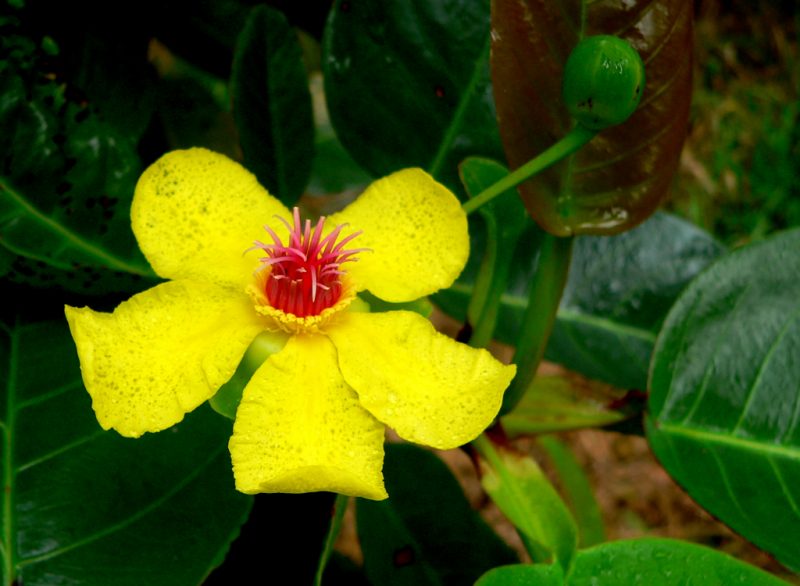Angiosperms or flowering - the most numerous department of the plant kingdom. What plants are hiding under these terms? The most important thing is simple and clear.
Material Content:
Angiosperms: General Description
235 thousand species of such plants are distributed throughout the planet.

A flower is the main hallmark of angiosperms. It can be of various shapes and types. They are responsible for reproduction. It is in the flowers that important processes of pollination, fertilization, the emergence and growth of the fetus occur.
Flowering seeds come in two forms. Seed with one share is a sign of the class of monocotyledonous. Seeds with two lobes form a class of dicotyledons.
It is generally accepted that monocotyledons are more adapted to changing environmental conditions.

The main differences between these classes are:
- on the structure of the roots (the fibrous root system of monocotyledonous against the core - dicotyledonous);
- on the formation of cambium (in monocotyledons it does not form);
- by the structure of the flower (simple perianth monocotyledon versus double in dicotyledons);
- by the structure of the embryo (the number of cotyledons of the embryo laid the foundation for the name of the class).
Signs of angiosperms
Plants have common signs of structure, development and reproduction.

The most important distinguishing features:
- various in structure flowers;
- there is a pistil that develops into the fetus;
- the pistil has stigmas that capture pollen;
- seeds are protected by the fruit;
- plants possess vessels (trachea).
Structure and reproduction
Flowering plant consists of root and shoot. Escape is a stalk, leaves, buds. Flowers grow from the buds.

The process of sexual reproduction of angiosperms begins with pollination.
Pollen is transferred from the stamens to the pestle.
Pollination is cross-pollination and self-pollination. Violets and peanuts are able to be pollinated while still not in the blooming flower of the same plant.
Most self-pollinating flowering pollinated within a single plant.

The second type of pollination is cross. Pollen is transferred from the stamens of male plants to the female pistils. Plants pollinated in this way are more viable because there is a gene exchange.

Pollen is carried by insects - a biotic method. Wind and water can also become pollinators. This is called the abiotic pollination method.
With artificial pollination, people carry pollen.
Angiosperms are distinguished by double fertilization.
It consists of several stages:
- pollen cells attach to the stigma of the pestle;
- developing and sprouting, they turn into a pollen tube, which grows into an ovary;
- sperm are secreted from the pollen tube and grows together with the ovary of the ovary;
- another sperm combines with the nucleus of the central cell of the embryo;
- as a result of fertilization, a zygote is formed.
The zygote divides and turns into an embryo, the central cell turns into an endosperm with a supply of nutrients.
Nutrients flow to the ovary, a ripe fruit is formed. Pericarp protects the seeds.
For flowering, vegetative propagation is also possible, that is, with the help of roots, shoots or leaves.
Examples of life forms of angiosperms
The life forms of flowering are diverse: annual and perennial grasses, shrubs and shrubs, vines, trees, shrubs and shrubs.
Trees are distinguished by the presence of a trunk and tall.

In shrubs, the trunk is not pronounced and hardly noticeable among the branch system (examples: currants, lilacs, acacia, raspberries).
They all have leaves consisting of leaf blades. A large area of leaf blades accelerates all the main processes of plants: photosynthesis, evaporation of moisture, respiration. The efficiency of these processes increases.
When adverse conditions (drought or low temperatures) occur, the leaves fall off. The leaf fall process allows you to save the life of the plant in an unfavorable period.
Shrubs are small in size, found in the tundra, in swamps and high in the mountains (examples: bearberry, northern linnaeus, winterhub, all marsh berries).
Shrubs and shrubs annually update their shoots (examples: Veronica, Potentilla, thyme).
Herbs bearing fruit for several years (perennial) are divided into species in the form of roots:
- rooted (legumes, alfalfa);
- Brush root (letter, plantain);
- short-rhizomes (fescue, bluegrass, thin woodland);
- long-rhizome (dentate, reed);
- tuberous (daffodils, tulips);
- bulbous (hyacinth, garlic).
Once a year, annual fruits (peas, dill) bear fruit.
Read also: what to do with daffodils after flowering

Another group is aquatic angiosperms. They are: coastal, semi-submerged, floating and underwater.
Protected Plant Species
Despite the high adaptability and wide distribution, there are species of flowering plants that need protection.
About 500 plant species are listed in the Red Book of Russia, which will soon disappear. Among them, 23 types of cereals: several varieties of feather grass, bluegrass, wheatgrass, etc.Oaks, maples and other trees also need protection and protection.

There are several ways to protect:
- arrangement of reserves, nature reserves and nature protection zones;
- cultural breeding of endangered species;
- restriction or termination of the procurement of valuable plant species.
Botanical parks and arboretums perform not only an environmental function, but also an educational one. In such places, you can get more information about protected plants and develop new ways to protect rare and endangered species.
The value of angiosperms in nature and human life
All these plants play a central role in shaping life on earth.
Most crops belong to this department.

Read also:planting and caring for daffodils in the open ground
The beauty of flowering is a source of inspiration for creativity, a beneficial effect on the nervous system.












